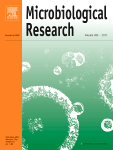Ver ítem
- xmlui.general.dspace_homeCentros e Institutos de InvestigaciónCIRN. Centro de Investigaciones de Recursos NaturalesInstituto de SuelosArtículos científicosxmlui.ArtifactBrowser.ItemViewer.trail
- Inicio
- Centros e Institutos de Investigación
- CIRN. Centro de Investigaciones de Recursos Naturales
- Instituto de Suelos
- Artículos científicos
- Ver ítem
GH10 XynA is the main xylanase identified in the crude enzymatic extract of Paenibacillus sp. A59 when grown on xylan or lignocellulosic biomass
Resumen
A novel bacterial isolate with polysaccharides degrading activity was identified as Paenibacillus sp., andnamed Paenibacillus sp. A59. Even though it is a strict mesophile, optimal xylanase activity of the crudeenzymatic extract was achieved between 50◦C and 70◦C and more than 60% of the activity was retainedafter incubation for 48 h at 50◦C, indicating thermotolerance of the enzymes involved. The extract wasalso active on pre-treated sugarcane residue
[ver mas...]
A novel bacterial isolate with polysaccharides degrading activity was identified as Paenibacillus sp., andnamed Paenibacillus sp. A59. Even though it is a strict mesophile, optimal xylanase activity of the crudeenzymatic extract was achieved between 50◦C and 70◦C and more than 60% of the activity was retainedafter incubation for 48 h at 50◦C, indicating thermotolerance of the enzymes involved. The extract wasalso active on pre-treated sugarcane residue (SCR) and wheat straw, releasing xylobiose and xylose asthe main products, therefore confirming its predominantly xylanolytic activity. By zymograms and massspectrometry of crude enzymatic extracts of xylan or SCR cultures, a 32 kDa GH10 beta- 1,4- endoxylanasewith xylanase and no CMCase activity was identified. We named this enzyme XynA and it was the onlyxylanase identified under both conditions assayed, suggesting that it is a good candidate for recombinantexpression and evaluation in hemicelluloses deconstruction applications. Also, a protein with two S-layerhomology domains (SLH) and a large uncharacterized C-terminal domain as well as an ABC substratebinding protein were identified in crude extracts of SCR cultures. We propose that Paenibacillus sp. A59uses a system similar to anaerobic and other Gram positive bacteria, with SLH-domain proteins anchoringpolysaccharide-degrading enzymes close to the membrane and the substrate binding protein assistingtranslocation of simple sugars to the cell interior.
[Cerrar]

Fuente
Microbiological research 186–187 : 16-26. (May–June 2016)
Fecha
2016
ISSN
0944-5013
Formato
pdf
Tipo de documento
article
Palabras Claves
Derechos de acceso
Abierto
 Excepto donde se diga explicitamente, este item se publica bajo la siguiente descripción: Creative Commons Attribution-NonCommercial-ShareAlike 2.5 Unported (CC BY-NC-SA 2.5)
Excepto donde se diga explicitamente, este item se publica bajo la siguiente descripción: Creative Commons Attribution-NonCommercial-ShareAlike 2.5 Unported (CC BY-NC-SA 2.5)


